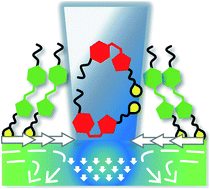Unexpected monolayer-to-bilayer transition of arylazopyrazole surfactants facilitates superior photo-control of fluid interfaces and colloids†
Abstract
Interfaces that can change their chemistry on demand have huge potential for applications and are prerequisites for responsive or adaptive materials. We report on the performance of a newly designed n-butyl-arylazopyrazole butyl sulfonate (butyl-AAP-C4S) surfactant that can change its structure at the air–water interface by E/Z photo-isomerization in an unprecedented way. Large and reversible changes in surface tension (Δγ = 27 mN m−1) and surface excess (ΔΓ > 2.9 μmol m−2) demonstrate superior performance of the butyl-AAP-C4S amphiphile to that of existing ionic surfactants. Neutron reflectometry and vibrational sum-frequency generation spectroscopy reveal that these large changes are caused by an unexpected monolayer-to-bilayer transition. This exceptional behavior is further shown to have dramatic consequences at larger length scales as highlighted by applications like the light-triggered collapse of aqueous foam which is tuned from high (>1 h) to low (<10 min) stabilities and light-actuated particle motion via Marangoni flows.

- This article is part of the themed collection: 2020 Chemical Science HOT Article Collection


 Please wait while we load your content...
Please wait while we load your content...